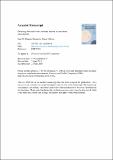Files in this item
Detecting abnormal events on binary sensors in smart home environments
Item metadata
| dc.contributor.author | Ye, Juan | |
| dc.contributor.author | Stevenson, Graeme | |
| dc.contributor.author | Dobson, Simon | |
| dc.date.accessioned | 2017-06-29T23:33:52Z | |
| dc.date.available | 2017-06-29T23:33:52Z | |
| dc.date.issued | 2016-12 | |
| dc.identifier | 243605797 | |
| dc.identifier | a6dbab3f-9b16-4c47-972f-e6b411052edc | |
| dc.identifier | 84979502175 | |
| dc.identifier | 000390637300003 | |
| dc.identifier.citation | Ye , J , Stevenson , G & Dobson , S 2016 , ' Detecting abnormal events on binary sensors in smart home environments ' , Pervasive and Mobile Computing , vol. 33 , pp. 32-49 . https://doi.org/10.1016/j.pmcj.2016.06.012 | en |
| dc.identifier.issn | 1574-1192 | |
| dc.identifier.other | ORCID: /0000-0002-2838-6836/work/68280971 | |
| dc.identifier.other | ORCID: /0000-0001-9633-2103/work/70234180 | |
| dc.identifier.uri | https://hdl.handle.net/10023/11120 | |
| dc.description.abstract | With a rising ageing population, smart home technologies have been demonstrated as a promising paradigm to enable technology-driven healthcare delivery. Smart home technologies, composed of advanced sensing, computing, and communication technologies, offer an unprecedented opportunity to keep track of behaviours and activities of the elderly and provide context-aware services that enable the elderly to remain active and independent in their own homes. However, experiments in developed prototypes demonstrate that abnormal sensor events hamper the correct identification of critical (and potentially life-threatening) situations, and that existing learning, estimation, and time-based approaches to situation recognition are inaccurate and inflexible when applied to multiple people sharing a living space. We propose a novel technique, called CLEAN, that integrates the semantics of sensor readings with statistical outlier detection. We evaluate the technique against four real-world datasets across different environments including the datasets with multiple residents. The results have shown that CLEAN can successfully detect sensor anomaly and improve activity recognition accuracies. | |
| dc.format.extent | 18 | |
| dc.format.extent | 3714856 | |
| dc.language.iso | eng | |
| dc.relation.ispartof | Pervasive and Mobile Computing | en |
| dc.subject | Ontologies | en |
| dc.subject | Smart home | en |
| dc.subject | Fault detection | en |
| dc.subject | Semantics | en |
| dc.subject | Domain knowledge | en |
| dc.subject | QA75 Electronic computers. Computer science | en |
| dc.subject | RA0421 Public health. Hygiene. Preventive Medicine | en |
| dc.subject | T Technology (General) | en |
| dc.subject | NDAS | en |
| dc.subject | BDC | en |
| dc.subject | R2C | en |
| dc.subject | ~DC~ | en |
| dc.subject | SDG 3 - Good Health and Well-being | en |
| dc.subject.lcc | QA75 | en |
| dc.subject.lcc | RA0421 | en |
| dc.subject.lcc | T1 | en |
| dc.title | Detecting abnormal events on binary sensors in smart home environments | en |
| dc.type | Journal article | en |
| dc.contributor.institution | University of St Andrews. School of Computer Science | en |
| dc.identifier.doi | 10.1016/j.pmcj.2016.06.012 | |
| dc.description.status | Peer reviewed | en |
| dc.date.embargoedUntil | 2017-06-29 |
This item appears in the following Collection(s)
Items in the St Andrews Research Repository are protected by copyright, with all rights reserved, unless otherwise indicated.

